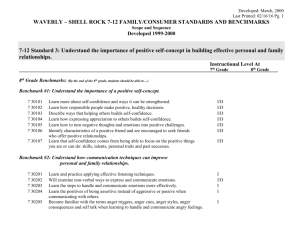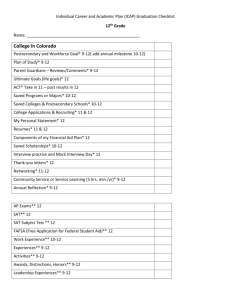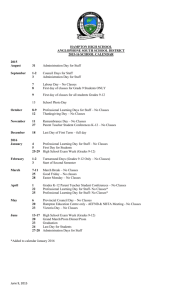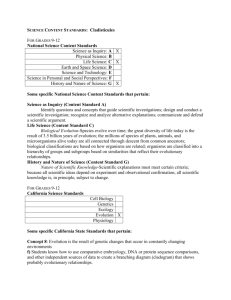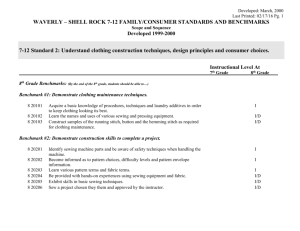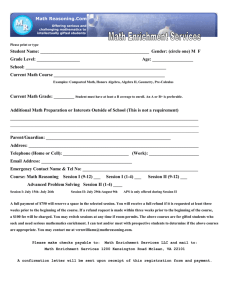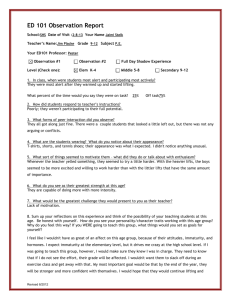Developed 1999-2000 - Waverly
advertisement
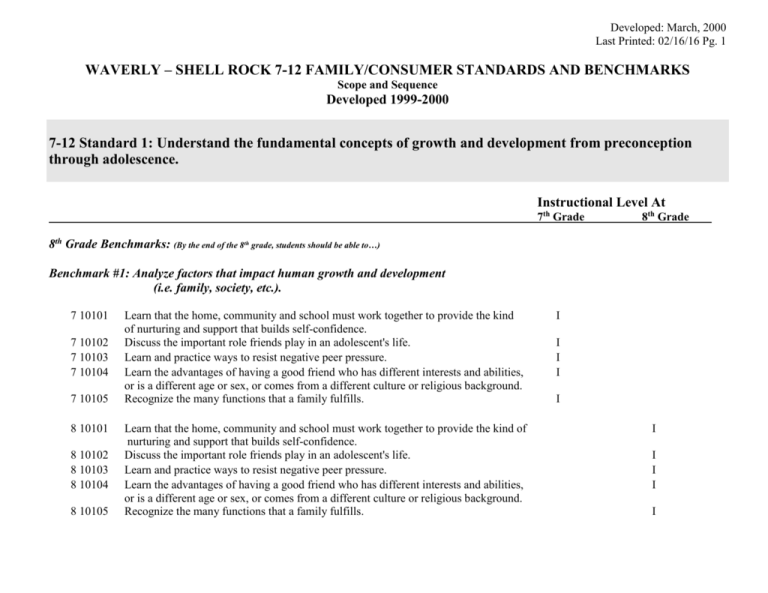
Developed: March, 2000 Last Printed: 02/16/16 Pg. 1 WAVERLY – SHELL ROCK 7-12 FAMILY/CONSUMER STANDARDS AND BENCHMARKS Scope and Sequence Developed 1999-2000 7-12 Standard 1: Understand the fundamental concepts of growth and development from preconception through adolescence. Instructional Level At 7th Grade 8th Grade 8th Grade Benchmarks: (By the end of the 8th grade, students should be able to…) Benchmark #1: Analyze factors that impact human growth and development (i.e. family, society, etc.). 7 10101 7 10102 7 10103 7 10104 7 10105 8 10101 8 10102 8 10103 8 10104 8 10105 Learn that the home, community and school must work together to provide the kind of nurturing and support that builds self-confidence. Discuss the important role friends play in an adolescent's life. Learn and practice ways to resist negative peer pressure. Learn the advantages of having a good friend who has different interests and abilities, or is a different age or sex, or comes from a different culture or religious background. Recognize the many functions that a family fulfills. Learn that the home, community and school must work together to provide the kind of nurturing and support that builds self-confidence. Discuss the important role friends play in an adolescent's life. Learn and practice ways to resist negative peer pressure. Learn the advantages of having a good friend who has different interests and abilities, or is a different age or sex, or comes from a different culture or religious background. Recognize the many functions that a family fulfills. I I I I I I I I I I Developed: March, 2000 Last Printed: 02/16/16 Pg. 2 Instructional Level At 7th Grade 8th Grade 8th Grade Benchmarks: (By the end of the 8th grade, students should be able to…) Benchmark #2: Understands the process of the developing adolescent. 7 10201 7 10202 7 10203 7 10204 7 10205 Identify and explore some of the normal physical changes of adolescence. Identify and explore some of the normal intellectual changes of adolescence. Identify and explore some of the normal social changes of adolescence. Identify and explore some of the normal emotional changes of adolescence. Examine social and coping skills needed to become a capable person. I I I I I Benchmark #3: Introduces and understanding of early childhood developmental education. 8 10301 8 10302 8 10303 8 10304 Evaluate the desirable characteristics of a child care provider. Be introduced to safety awareness while providing care for children. Evaluate toys and activities for age appropriateness of children. Assess their own talents and how to use them in child care situations. I I I I Developed: March, 2000 Last Printed: 02/16/16 Pg. 3 Instructional Level At Course #1 Course #2 Course #3 12th Grade Benchmarks: (By the end of the 12th grade, students should be able to…) Benchmark #1: Analyze factors that impact human growth and development (i.e. family, society, etc.). 9-12 10101 9-12 10102 9-12 10103 9-12 10104 Investigate the impact of heredity and environment on human growth and development. Describe the impact of social, economic, and technological forces on individual growth and development. Recognize the effects of gender, ethnicity, and culture on individual development. Identify the effects of life events on individuals' physical and emotional development. . . . . Benchmark #2: Analyze principles of human growth and development across the life span. 9-12 10201 9-12 10202 Describe physical, social, emotional, and intellectual development as it occurs from birth through adulthood, including individuals with special needs. Recognize the interrelationships among physical, emotional, social, and intellectual aspects of human growth and development, how they change and effect human growth and development throughout the life span. . . Course #4 Course #5 Developed: March, 2000 Last Printed: 02/16/16 Pg. 4 Instructional Level At Course #1 Course #2 Course #3 Course #4 12th Grade Benchmarks: (By the end of the 12th grade, students should be able to…) Benchmark #3: Evaluate the impact of parenting roles and responsibilities on strengthening the well being of the individual and maximizing human growth and development. 9-12 10301 9-12 10302 9-12 10303 9-12 10304 9-12 10305 9-12 10306 9-12 10307 Examine parenting roles across the life span. Examine expectations and responsibilities of parenting. Explain cultural differences in roles and responsibilities of parenting. Examine biological processes related to prenatal development, birth, and health of children. Identify community resources and services available to families. Review current laws and policies related to parenting (including child abuse). Recognize the differences and effects of parenting styles as they apply to development. . . . . . . . Benchmark #4: Understands the process of the developing adolescent. 9-12 10401 9-12 10402 Recognize the unique developmental processes of the adolescent. Recognize the impact of adolescent development on the family unit. . . Benchmark #5: Evaluate and demonstrate an understanding of early childhood developmental education. 9-12 10501 9-12 10502 9-12 10503 Describe ways to guide the physical, social, emotional, and intellectual development of children including those with special needs. Select toys, equipment, food, and materials appropriate for the developmental stage of a child. Select and use appropriate child guidance techniques. . . . Course #5 Developed: March, 2000 Last Printed: 02/16/16 Pg. 5 Instructional Level At Course #1 Course #2 Course #3 12th Grade Benchmarks: (By the end of the 12th grade, students should be able to…) Benchmark #5: Evaluate and demonstrate an understanding of early childhood developmental education. 9-12 10504 9-12 10505 9-12 10506 9-12 10507 9-12 10508 9-12 10509 Identify types of child abuse, neglect and intervention options. Identify and recognize childhood diseases and immunization procedures. Identify ways to provide a safe environment for a child. Recognizes the various developmental theories and their applications. Develop problem-solving techniques. Evaluates early childhood educational programs. . . . . . . Benchmark #6:Understands the process of conception, prenatal development, birthing and the development of the child throughout adolescence. 9-12 10601 9-12 10602 9-12 10603 9-12 10604 9-12 10605 Describe sexual reproduction and the birthing process. Analyze contraception and family planning methods. Recognize health concerns and needs at various stages of prenatal and postnatal development. Identify the additional risks and concerns related to teen pregnancy and parenting. Describe procedures for prevention and control of diseases (i.e. sexually transmitted diseases). . . . . . Course #4 Course #5
